Mountains & Minds: Learners and Leaders
Access
Goal:
Montana State University is committed to widening access to higher education and ensuring equality of opportunity for all.
Objective A.1: Educate more students while maintaining the quality of programs.
Metric A.1.1: By 2019, the number of Montana undergraduate students enrolled will surpass 9,900 (a 15 percent increase).
Technical note: Fall 2011 headcount resident UG enrollment was nearly 8,600. A 15 percent increase will move that figure to 9,900. This target will require MSU to increase recruitment of recent high school graduates, increase opportunities for nontraditional Montana students and improve retention of those students once they enter MSU.
Metric A.1.2: By 2019, the number of new transfer enrollments will increase 15 percent to approximately 1,100.
Technical note: Available in Registrar Report A-B, summer and fall transfers: http://www.montana.edu/opa/enrollment/. If counting summer, fall, and spring, transfers, new enrollments will increase 15% to 1,530.
Metric A.1.3:By 2019, the number of students enrolled in graduate programs will increase 20 percent to approximately 2,350.
Technical note: Fall 2011 headcount grad enrollment was 1,965. A 20 percent increase will move that figure to 2,358. This same metric is in the Discovery section of this plan. This metric is consistent with Objective 2.3.1 in the MUS Strategic plan http://mus.edu/data/StratPlan/13_Goal_2_Graduate_Education_2012.pdf.
Metric A.1.4: By 2019, the number of credits and courses delivered online will increase 40 percent to approximately 20,000 credits and 225 courses.
Technical note: In FY2012, there were 14,755 credits and 484 sections in 162 courses delivered on-line by MSU. A 40 percent increase would take credits to 20,600 and courses to 226. That increase would represent more than 2,000 new enrollments in three-credit courses. These figures are reported annually in to the Office of the Commissioner for Higher Education.
Metric A.1.5: By 2019, the number of students enrolled in Gallatin College degree and certificate programs will double to 400.
Technical note: Key Performance Indicators, http://www.montana.edu/opa/kpi/index.html.
Metric A.1.6: By 2019, the percentage of need met through scholarships and grants for students who were awarded any need-based aid will increase from 74 percent to 80 percent.
Technical note: Need-based aid includes federal, state and institutional scholarships and waivers,
as well as work study. Need-based aid does not include loans. Increasing the percentage
of aid met will likely mean a combination of minimizing costs to students and increasing
financial aid funding sources and amounts. Common Data Set, Student Financial Aid,
Bookmark H, Line I. http://www.montana.edu/opa/cdsindex.html
Metric A.1.7: By 2019, the total student population will increase 15 percent to 16,000.
Technical note: Fall 2011 headcount enrollment was 14,153. Growing MSU’s graduate student population, Gallatin College population and undergraduate retention rates as specified in this plan will bring total enrollment to approximately 16,350.
Objective A.2: Diversify the student body
Metric A.2.1: By 2019, the number of Native American students enrolled will increase to 800 (a 45 percent increase).
Technical note: Between 2010 and 2011, enrollments by Indian students increased 9 percent. This target represents a further increase of 45 percent over the next six years. This metric counts American citizen students identifying as American Indian/Alaska Native with or without any other racial or ethnic identifications. This metric is consistent with OCHE race and ethnicity definitions, but differs from federal race and ethnicity reporting.
Metric A.2.2: By 2019, the number of other under-represented minority students enrolled will increase to 1300 (a 40 percent increase).
Technical note: MSU’s ethnic and racial minorities currently make up less than 7 percent of the student population. The targeted increase will increase under-represented minority enrollment to more than 8 percent of the campus population. This metric counts American citizen students identifying as Hispanic, Asian, Black or Native Hawaiian with or without any other racial or ethnic identifications. This metric is consistent with OCHE race and ethnicity definitions, but differs from federal race and ethnicity reporting. Non-responses and international students are excluded.
Metric A.2.3:By 2019, the number of international students enrolled will increase to 660 (a 20 percent increase).
Technical note: In Fall 2011, MSU enrolled 553 international students or 4 percent of the student body. This metric counts non-US citizens regularly enrolled in MSU credit-bearing courses. ACE Language Institute students or other short-term, non-credit program participants are not included. This definition is consistent with OCHE and federal definitions.
Metric A.2.4: By 2019, the number of nontraditional students enrolled in undergraduate and Gallatin College programs will increase to 3,200 (a 20 percent increase).
Technical note: In Fall 2011, 2,655 students aged 24 and over enrolled as undergraduates at MSU, about 22 percent of the undergraduate population. Among newly admitted students, the proportion 24 and older is only 14 percent. To achieve this target, we will need to recruit and retain additional nontraditional students. Metric taken from fall enrollment reports.
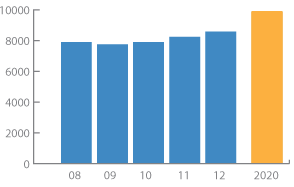
Metric A.1.1:Montana Undergraduate Enrollment
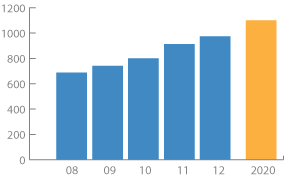
Metric A.1.2:New Transfer Student Enrollment
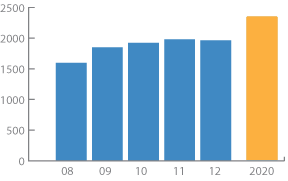
Metric A.1.3:Graduate Student Enrollment
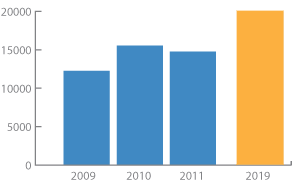
Metric A.1.4:Online Credits Enrolled
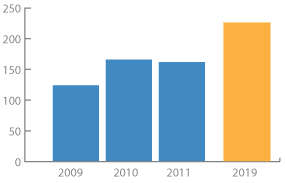
Metric A.1.4:Online Courses
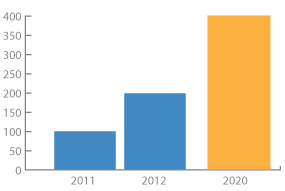
Metric A.1.5:Gallatin College Enrollment
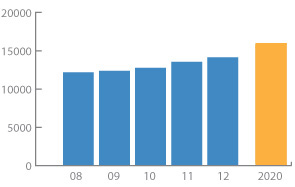
Metric A.1.6:Percent of Financial Need Met
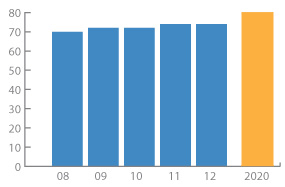
Metric A.1.7:Total Headcount Enrollment
